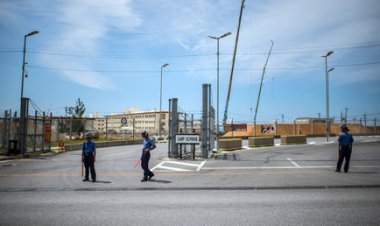Nasdaq enters bear market, worsening Trump tariff tailspin
Wall Street experienced a significant decline for the second consecutive day on Friday, marking the Nasdaq Composite's entry into a bear market and pushing the Dow Jones Industrial Average into correction territory. This downturn was driven by an intensifying global trade war, resulting in the largest losses the market has seen since the pandemic.

The Dow Jones Industrial Average, S&P 500, and Nasdaq Composite registered their largest two-day decreases since the panic triggered by the coronavirus at the start of U.S. President Donald Trump's first term. Over Thursday and Friday, the Dow fell by 9.3 percent, the S&P 500 by 10.5 percent, and the Nasdaq by 11.4 percent.
Trump's extensive tariffs heightened fears of a global recession, erasing trillions of dollars in value from U.S. companies. The surge in anxiety among investors was reflected in the CBOE Volatility Index, commonly viewed as Wall Street's fear gauge, which closed at its peak since April 2020.
Beginning late Wednesday, after Trump raised tariff barriers to their highest levels in more than a century, investors began to offload stocks. They were wary not only of the new economic landscape in the U.S. but also of how trading partners might respond by imposing their own trade restrictions.
Trading volume reached unprecedented levels on Friday, with approximately 26.79 billion shares changing hands on U.S. exchanges, surpassing the previous record of 24.48 billion shares on January 27, 2021.
On Friday, the Nasdaq declined by 962.82 points, or 5.82 percent, finishing at 15,587.79. This confirmed that the tech-focused index is in a bear market relative to its record closing high of 20,173.89 set on December 16.
Additionally, the Dow Jones Industrial Average dropped by 2,231.07 points, or 5.50 percent, closing at 38,314.86 points, confirming a correction from its record high of 45,014.04 on December 4.
The S&P 500 fell by 322.44 points, or 5.97 percent, ending at 5,074.08 points, marking its lowest close in 11 months.
"Right now, how bad it gets depends on how committed the administration is to this set of policies which, clearly, the market is voting against," said Steve Sosnick, chief strategist at Interactive Brokers.
In response to Trump's tariff announcement, global governments began reacting, further diminishing investor sentiment that a global recession could be avoided. JP Morgan indicated a rising forecast for global recession risks, increasing the probability to 60 percent, up from 40 percent previously.
China's finance ministry announced it would implement an additional 34 percent tariff on all U.S. goods starting April 10. Meanwhile, the prime ministers of Britain, Australia, and Italy engaged in discussions regarding responses to Trump's tariffs.
"We're in the Wild West of a trade war right now," said Mariam Adams, managing director at UBS Wealth Management.
For the week, the S&P 500 experienced a decline of 9.1 percent, while the Dow fell by 7.9 percent and the Nasdaq slumped 10 percent.
Federal Reserve Chair Jerome Powell addressed the public for the first time since the announcement of the tariffs, noting that the unexpectedly high tariffs could lead to increased inflation and slower economic growth, which would create difficult decisions ahead for U.S. central bankers.
In the bond market, safe-haven buying drove the yield on the benchmark 10-year Treasury notes below 4 percent, contributing to further declines in U.S. bank stocks. The banking sector faced global pressure, as the potential for interest rate cuts by central banks and the impact of tariffs on economic growth posed threats to profitability, with the S&P Banks index dropping 7.3 percent.
All 11 S&P sectors fell by more than 4.5 percent, with energy stocks facing the most significant losses for the second consecutive day, dropping 8.7 percent in line with a 7.3 percent decline in U.S. crude prices.
Aarav Patel contributed to this article for TROIB News
Find more stories on Business, Economy and Finance in TROIB business












